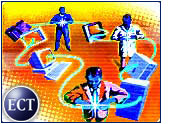
Maybe it’s a bad self-image brought on by the hundreds of good companies strewn by the wayside. Or a belief that people will be ready one day to buy more online — just not yet.
Whatever the cause, something is holding e-commerce back from reaching its potential. Short of sending the industry to a Tony Robbins seminar, what can be done to unleash the true power of the e-commerce?
The answer: plenty.
E-tailers have been focusing on the big events and the potential those events promise. For example, the way Web merchants rise to meet the challenges of the holiday shopping season is impressive. But what about the little opportunities that, taken together, are just as big?
If the goal is still to make e-commerce part of the everyday world — something that people take for granted as much as they do the 7-Eleven on the corner and the Starbucks across the street — Web vendors are going to have to blanket the retail world.
Back-to-the-Web
Take back-to-school for instance. Already, we’re hearing that e-tailers are busy preparing for the annual holiday shopping season when, lo and behold, another major shopping season appears between here and there.
Is everything possible being done to lure back-to-school shoppers online? I doubt it. Yes, there are limitations: Mom’s going to want to see her second grader in those new pants before she plunks down the virtual cash.
But there are pluses to getting ready for the new school year through online shopping, and e-tailers are not doing enough to make that clear.
How about shopping at night and spending those extra three days on the beach? What about avoiding the long lines at the campus bookstore by ordering texts online? These are the kind of things we need to hear more about.
Cha-Ching
Then there’s the unexpected tax-rebate season, which we’re entering at the same time.
Thanks to President Bush’s tax cut, millions of taxpayers will have checks show up in their mailboxes starting in the next week or two. What will they do with the money? That remains to be seen, but clearly many people, including the president, hope they’ll rush out and spend at least some of it.
Why shouldn’t they spend it online? More to the point, why shouldnt they already be hearing about the reasons for them to do so?
A quick promotion here, a discount over there. Not the self-defeating price-cutting that paved the way for so many dot-com deaths, but a few, reasonable promotional price cuts and you’d have people thinking twice about where to plunk that rebate check down.
Pounce-ability
For the medium with one of the speediest methods of communication at its disposal, e-commerce is slow on the uptake.
Think about it. When gas prices shot through the roof this spring, not one of the e-tailers who has its paws on my e-mail addresses bothered to ping me with a note suggesting I keep the car parked and buy my books, music, clothes, kitchen appliances and electronics — you name it — via the Net.
All these little marketing opportunities are small doors being opened just a crack, but enough for smart e-tailers to jump in, blow their trumpets and make some real noise.
Yet e-commerce continues to sit back on its haunches, resting up for the big battles.
Selling Is Believing
Maybe there’s a sense that the noisiest vendors will be the first taken out of the game. Maybe there’s a reluctance to scare customers off. Exactly how much hard-selling to do is a fine line, to be sure.
But a sense of confidence goes a long way. E-commerce has a lot going for it. Believing that is the first step. Only then will others be convinced.
What do you think? Let’s talk about it. ![]()
Note: The opinions expressed by our columnists are their own and do not necessarily reflect the views of the E-Commerce Times or its management.



























































Kevin, I like your perspective on this issue. I guess people like us on this message board are preaching to the choir as we likely all have embraced the web and buy stuff on it each week. I share my on line buying exeperiences with friends and family frequently as sort of my own personal campaign to build their confidence. Sites like Papajohns.com are so well laid out and easy to use that that should be a commerce 101 requirement for all Americans that like to order out pizza. These types of low risk experiences will help the masses get on line.
Keith,
Thanks for the article. I guess there is a reluctance to use any of the “old” ways of doing things when it comes to the “new” e-biz. Thanks for reminding me that some of the old still works with the new.
Bob
I have to agree with you about obsene waste and bad mapping. The web is too big. If we humans have too much on our plate we don’t know where to start and the marketers take the driving seat. But localising and putting fences up may help the consumer pysche feel more comfortable. Things have to get to local roots not global transparency when shopping.
Holding back….
First thing comes to mind for me personally is afforable and available BROADBAND! I live in a
relatively dense area, shopping center nearby, tv cable, lots of phone lines. BUt too far out
for DSL, our local TV cable hasn’t upgraded or added Internet to theri mix yet, and Satelite
is way too expensive still. I own a Internet business, and from my contacts, Broadband , speed
seems to be in the top 5.
Also…an internet venture of which I AM a part, also offers hard copy catalogs to our clients,
members and independant business owners. Smart move. Helps new E-com shoppers have a
catalog in their hands and then we teach them one on one, how to order using the SKU
nubmers OR using the site. Whatever works eh.? JNVC
Kevin, I do agree on the point it must take off from small value items and go big with increase in confidence. As of now, I believe, two factors are holding back strongly on high value transactions. 1.Uncertainty of virtual buying, as there are no international legal laws framed and widely known particularly, for trans border purchases. 2.E-commerce transactions, as of now, are not projected profitable to the extent of expectations and worth of risk-taking by a common buyer. 3.The government and legal bodies have a lot of roles to play in addressing these issues in promoting through various schemes, which as of now are missing across the globe and not only in US.
It’s a good point that the convenience offered by shopping on-line is what companies need to sell to consumers but how they do it is the key. At present consumers are more likely to buy commodities like books, CD’s, DVD’s, airline tkts etc over the net than they are clothes or perhaps furniture. The latter have a higher level of the “touchy feely” factor. Similarly, with groceries, canned produce is a more likely seller than fresh produce.
Keith:
Your spot on! Notice how Walmart announced they would cash ‘tax-refund’ checks, with no questions asked. That’s the stuff leaders are made of.